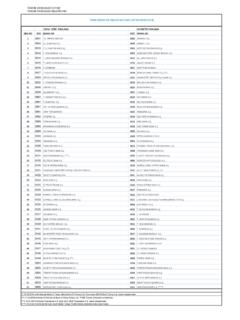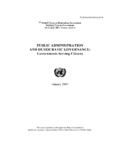Transcription of Talaat Pasha's Report on the Armenian Genocide
1 Gomidas Institute Studies SeriesTALAAT PASHA S Report ON THE Armenian GENOCIDEby Ara SarafianGomidas InstituteLondonThis work originally appeared as Talaat Pasha s Report on the ArmenianGenocide, 1917. It has been revised with some changes, including a new by Taderon Press by arrangement with the Gomidas Institute. 2011 Ara Sarafian. All Rights 978-1-903656-66-2 Gomidas Institute42 Blythe W14 0 HAUnited KingdomEmail: by Ara Sarafian5 Map18 Talaat PASHA S 1917 REPORTO pening Summary Page: Data and Calculations20 WESTERN PROVINCES (MAP)22 Constantinople23 Edirne vilayet 24 Chatalja mutasarriflik25 Izmit mutasarriflik26 Hudavendigar (Bursa) vilayet 27 Karesi mutasarriflik28 Kala-i Sultaniye (Chanakkale) mutasarriflik 29 Eskishehir vilayet 30 Aydin vilayet31 Kutahya mutasarriflik32 Afyon Karahisar mutasarriflik 33 Konia vilayet34 Menteshe mutasarriflik35 Teke (Antalya) mutasarriflik36 CENTRAL PROVINCES (MAP)37 Ankara (Angora) vilayet 38 Bolu mutasarriflik39 Kastamonu vilayet40 Janik (Samsun) mutasarriflik 41 Nigde mutasarriflik42 Kayseri mutasarriflik43 Adana vilayet44 Ichil mutasarriflik45 EASTERN PROVINCES (MAP)46 Sivas vilayet47 Erzerum vilayet48 Bitlis vilayet494 Talaat Pasha s Report on the Armenian GenocideVan vilayet50 Trebizond vilayet51 Mamuretulaziz (Elazig) vilayet 52 SOUTH EASTERN PROVINCES AND RESETTLEMENT ZONE (MAP)
2 53 Marash mutasarriflik54 Aleppo (Halep) vilayet55 Urfa mutasarriflik56 Diyarbekir vilayet57 Syria vilayet 58 Zor mutasarriflik59 Mosul vilayet60 Beirut vilayet 61 Jerusalem (Kudus-i Sherif) vilayet62 Appendix 1: A Report from the Turkish Military Archives65 Appendix 2: Talaat s Black Booklet 67 Map 1: Destruction of Armenians in the Ottoman Empire, 1915-17insertMap 2: Surviving Armenian Deportees in the Ottoman Empire, 1917insertIntroductionTalaat stated that they had already disposed of three quarters of them[Armenians], that there were none left in Bitlis, Van, Erzeroum, andthat the hatred was so intense now that they have to finish it.. Hesaid they would take care of the Armenians at Zor and elsewhere butthey did not want them in Anatolia. I told him three times that theywere making a serious mistake and would regret it. He said, We knowwe have made mistakes, but we never regret.
3 Diaries of Ambassador Henry Morgenthau1 Supervising the Destruction of ArmeniansThroughout 1915 16, Talaat Pasha, the Ottoman Minister of Interior,supervised the destruction of Armenians in the Ottoman this process as a security measure, he ordered the generaldeportation of Armenians and oversaw the break-up of communities, thesystematic confiscation of property, forced conversions, the disappearanceof hundreds of thousands of people, and the dispersion of survivors acrossthe empire. Talaat received progress reports from different provinces and,at the end of 1916, ordered a general assessment of his work. On 24 August 1916, he sent a cipher telegram to 34 provinces (vilayets andmutasarrifliks) asking for detailed information about the presence ofArmenians in different parts of the His circular was simple andto the point: he wanted to know how many Armenians there were in eachprovince, how many were native (yerli), and how many were outsiders (yabanc ).
4 Six months later, on 11 February 1917, he sent another ciphertelegram, this time to 23 provinces, calling for a headcount Once more, he asked for the number of native and outsider Armenians in each s Report on the Destruction of Ottoman ArmeniansIn 2008 the Turkish journalist and historian Murat Bardak published areport from Talaat s private papers concerning Armenians in theOttoman This Report was obviously commissioned by TalaatPasha and was obtained from his widow shortly before her death It was based on a study showing the distribution of Armenians inOttoman provinces and was prepared with great care. Although it boreno date, title, or formal introduction, the document started with6 Talaat Pasha s Report on the Armenian Genocidesummary calculations of the number of Ottoman Armenians in 1914 and1917.
5 These calculations gave a breakdown of the number of Armeniansin each province in 1914, as well as the number of Armenians from eachprovince counted in different parts of the Ottoman Empire in Anote pointed out that the raw figures were undercounts and estimated theprewar Ottoman Armenian population (excluding Protestant Armenians)at approximately 1,500,000 people, with 350,000 to 400,000 Armeniansof all denominations remaining in 23 provinces in According toTalaat s adjusted figures, around 1,150,000 Ottoman Armenians (or 77percent) had disappeared between 1914 and Archives and the Deportation of ArmeniansIn recent years, the Turkish Prime Ministry Ottoman Archives hasreleased a range of records related to the treatment of OttomanArmenians during World War I. These include the texts of theaforementioned two cipher telegrams of 1916 and 1917, some of theresponses to those telegrams, and a range of other records related to thedeportation of Armenians.
6 These new archival materials, thoughincomplete, demonstrate Talaat s intimate involvement with thedeportation of Armenians, and show that his Report of 1917 was based onthe results of his circular of 11 February example, soon after the first deportations in 1915, Talaat requestedand received telegraphic and written reports of the number of peopledeported from different areas. In the case of Sivas (central kaza), forexample, 21,446 Armenians (4,453 households) were deported from apopulation of 26,895 Armenians (5,032 households) and 5,449 Armenians (579 households) remained According to thesefigures, around 80 percent of Armenians had been deported from thecenter of the province. For the province as a whole, it was reported that136,084 Armenians had been deported, with an additional 6,055prepared for In Kayseri, 44,271 were said to have beendeported from a reported Armenian population of 49,947 people.
7 Also,765 deportees were reported as rearrested after escaping and returningback to Kayseri. The Kayseri Report also added that the remaining 4,911 Armenians were earmarked to be scattered in Muslim villages so that theywould not make more than five percent of the population in Another Report from Janik, on the Black Sea coast, reportedthat 25,476 Armenians (4,229 households) had been deported out of27,453 Armenians (4,251 households).12 According to these figures, theIntroduction7deportation rate from this Black Sea province by the end of 1915 wasover 72 These initial reports from 1915 did not elaborate onthe status of those who remained behind and we do not know how manywere men who had been conscripted into the Ottoman army orArmenian converts to flow of information continued with special instructions from theOttoman capital and local assessments of deportations.
8 Fourteen monthsafter the general deportations had begun, Talaat s circular of 24 August1916, and then his circular of 11 February 1917, solicited new data onthe Armenian issue: while the August circular requested informationbased on local records dealing with the deportation of Armenians, theFebruary circular asked for a new headcount of Armenians. Both circularsasked the central question about the number of native and outside Armenians in each province, but they differed in the additionalinformation they requested. The August circular asked about Armenianswho had not been deported because they were Catholics or Protestants,members of soldiers families (asker ailesi), converts to Islam, or hadspecial permission to remain;14 the February circular asked for additionalinformation on the geographical origins of outside Armenians in responses to the August 1916 circular gave Talaat an overallreassessment of the results of his deportation In the case ofKayseri, for example, this latest set of results maintained that 6,761 Armenians remained from a prewar population of over 50, According to these figures, around 77 percent ofArmenians had been deported from this In the case ofHudavendigar (Bursa) province, 2,999 Armenians remained from aprewar population of over 60, According to these figures, around95 percent of Armenians had been deported from Hudavendigar.
9 In thecase of Marash, of 39,901 Armenians,19 there remained 2,442 ApostolicArmenians, 2,028 Catholic Armenians, and 1,813 Protestant Armenians,as well as 290 converts to Islam. According to these figures, by the end of1916, 84 percent of Armenians had been deported from this Inthe European province of Edirne, where there had been over 19,000 Armenians in 1914, only 4,583 people remained by the end of 77 percent had been months later, the 11 February 1917 circular yielded more data that, aswe argue, formed the basis of Talaat Pasha s Report of 1917. In the case of8 Talaat Pasha s Report on the Armenian GenocideKastamonu, for example, the returns stated that there were 3,436 nativeand 188 outside Armenians in that province. This data was practically thesame in Talaat s Report , which noted 3,437 native and 185 outsideArmenians for The return from Ankara province counted12,766 native and 451 outside Armenians.
10 Talaat s Report gave the figuresof 12,766 and 410 The figures for Bolu were 1,608 nativeArmenians and 549 Talaat s Report noted 1,539 locals and551 outsiders. In the case of Karesi, the return reported 1,852 native and246 outsiders. Talaat s Report recorded 1,852 native and 124 Beirut, the return counted 50 natives and 1,980 outsiders. Talaat sreport noted 50 natives and 1,849 In the case of Syria, the1917 return counted 39,400 outside and no native Ta l a a t sreport gave the figures of 39,409 outsiders and no native sets of data show that Talaat s Report was closely related to 11 February 1917 circular. The data appears to have been checked andupdated using additional s entry for Der Zor is particularly revealing. It recorded 201 nativeand 1,570 outside Armenians, and then amended the figure for outsideArmenians to 6,778 in a footnote citing additional telegraphicinformation.







